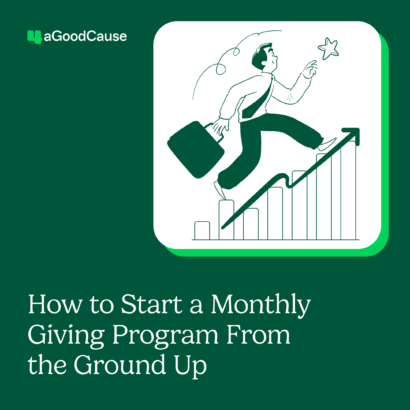As crazy as it may seem, we are officially closer to the end of the year than we are to the beginning. Summer is wrapping up and fall is headed our way. As the year heads towards a close, nonprofits are beginning to plan their end-of-year fundraising, which can be a tricky process. What content should you include? Should you appeal to reason or emotion?
4aGoodCause wants to help you craft your year-end fundraising appeals and CTAs this year. We took the time to chat with Claire Axelrad, J.D., CFRE, with Clairification, a behind the scenes nonprofit and philanthropy coach, about crafting the perfect year-end fundraising appeal this year.
Q. Can you talk to us about the process of putting a year-end fundraising appeal together? What elements and content should nonprofits be including?
A. This is a big question, as it goes to the heart of how to craft an offer your donor can’t refuse. In a nutshell, you need three things:
- The problem you’re addressing – and you need to make it seem real and relevant to the prospective donor.
- The solution you’re proposing to address the problem – with your donor’s help.
- Specifically how they can help – the purpose and the amount of the gift you’re requesting.
There are all sorts of critical elements to consider (I cover them all in my Anatomy of a Fundraising Appeal Letter e-Guide). What’s a bit different about your year-end appeal, however, is the urgency.You must persuade your donor to act now, during the most giving time of year.
Different studies show that many nonprofits will raise 25 – 30% or more of their total annual campaign goal from mid-November through December 31st. Online giving is particularly frenetic at this time of year. A study by Network for Good and True Sense Marketing found that a third of all online giving occurs in December, and more than 20% of all online giving for the entire year occurs on the last two days of the calendar year.
It’s easy to add urgency to your appeal right now. Even informing your readers that this is a “special year-end appeal” adds some sense this is pressing and prompts people to act. People understand that endings lead to beginnings, so it makes sense that as you close up this year you’ll be planning ahead to do even more in the coming months. You need their support now so you’ll be able to assure you won’t have to let anyone down in the new year. Other ways to add urgency during these months (depending on your cause) are to mention how difficult it is to be alone during the holidays, or to be on the street during the cold weather. And my favorite way to add urgency is to consider a matching challenge grant. Donors love to leverage their money and, in my experience, knowing their gift will be doubled has powerful persuasive impact.
Q. Should nonprofits be breaking down their appeals to cater to different groups of donors and supporters? If so, what are the different types of appeals they can be sending out?
A. Yes! One of the findings from Penelope Burk’s groundbreaking research in “Donor-Centered Fundraising” is that donors want you to “show them you know ‘em.” So segment your appeal by folks’ affiliation with you. If someone has given to you in the past, it’s important to acknowledge this and thank them. If they’re on your board, or a direct service volunteer, or a parent, subscriber, patient, alum, or you-name-it, if you can acknowledge that connection in your appeal you should.
The other way you’ll want to segment your appeal is by donation amount. Someone who’s given you less than $100 should receive a different appeal than someone who gives you $500 or more. In the case of smaller donors, you may ask them to repeat their giving by suggesting a string of amounts that will be reflected in your remit piece or donation landing page. For larger donors, you may ask for a specific amount that matches (for first-time donors) or is greater than (for repeat donors) what they gave previously. And you’ll want to use a higher-end response device.
Q. What elements or content should nonprofits include that will help appeals seem more personal and less like a sales pitch?
A. Be genuine and sincere, and get to the point. No one wants to be taken down the proverbial, meandering garden path. Donors deserve to know specifically what you’re asking for, and why, with nothing hidden. I once wrote an article about “8 Tips Fundraisers Can Learn from Street Beggars,” and among the takeaways are the need to present a tangible, realistic goal that can be reached by an amount the donor can reasonably consider.
It’s also important to write using a friendly style. Indent paragraphs. Write like you talk. Contractions are okay. So is beginning a sentence with a preposition. Avoid jargon and corporate-speak. And keep everything at a 4th – 6th-grade level. Don’t worry that this is infantilizing! People skim letters and emails. They’re starved for time. Don’t make them work too hard to understand what you’re trying to convey. Anything that makes folks slow down and have to think is bad for your response rate.
You also should get to the point quickly.
Q. What elements will motivate donors to respond and react?
A. Tell a compelling story about one person, place or thing. Avoid dry recitations of facts. People are wired for stories. Folks instinctively want to embrace them and even enter into them. Your goal with your story? To motivate your donor to swoop in to be the hero who gives the story a happy ending! There’s plenty of research showing you’ll get larger gifts if you simply tell a story about one person. Why? It’s more credible and doable for your donor than trying to save 86,000 lives. For inspiration, see what Seth Godin has to say about nonprofit stories.
Also include compelling visuals. A picture really is worth 1,000 words and, remember, folks are busy! Add a photo, ideally of one person donors can help, to your mail or email appeal. Also, use visuals on social media. Folks pay more attention on social networks if you include donation impact graphics.
Q. Should nonprofits appeal to reason or emotion in their appeals?
A. Emotion, emotion, emotion! The best way to persuade folks to give is to trigger empathy. Help people to walk in the shoes of others. It’s a little-known fact that Darwin argued that the most “fit” societies were the most empathic. We’re a profoundly social and caring species, with sympathy being a stronger instinct than self-interest.
I like to begin an appeal with a single emotion-packed sentence that enables people to imagine the situation with which they’re confronted. “Jimmy will go to bed hungry tonight.” “Jane is afraid of her father.” “Jessie died from drinking dirty water.”
Once you’ve captured folks’ attention, you can continue the story with something like “Jimmy goes to bed hungry every night, ever since his single mother lost her job. Sometimes, because he slept so poorly, he falls asleep at school.”
As the reader continues, they begin to envision what Jimmy’s life must be like, and their heart softens. As you’ve no doubt heard it said, the heart rules the head. Appeal to your donors’ hearts.
Q. How can nonprofits be writing donor-centered copy?
A. The simplest trick I know is use of the word “you.” This makes it about the donor. It becomes personal. Much better than “we do this” and “our organization does that.” Any place you’re tempted to say “our” or “name of organization” or “we” (unless it’s “we, together”), don’t. Make your appeal be all about what your donor has accomplished, and will accomplish, with their generosity and caring.
The other important thing, of course, is to write to donors about what they most care about. If you are able to segment your donor database by area of interest (e.g., Mary always gives to children’s services; Sam gives to senior services), this can help you.
Q. What are some good examples of great call-to-actions?
A. “Action” implies the need to use action verbs. Save, support, change, act, give, invest, fight, fix, intervene, repair, transform… The more powerful, the better. Calls to action should be succinct as well, and should answer the questions “Why am I taking this action? What difference will it make?”
Simply stating “Give today” doesn’t answer this important “why should I give?” question.
Oxfam America does a great job with “Save lives in Syria.” I also like Share Our Strength’s simple “Donate to help end hunger,” Habitat for Humanity’s Help build houses and hope,” and Sierra Club’s“Be a champion for the environment.” There are lots of great examples.
Q. How important is a well-crafted year-end fundraising appeal for a nonprofits strategy? Do you have any specific stats or stories to share that show how a quality appeal can benefit a nonprofit?
A. My best advice is to treat year-end giving as a campaign, not a single appeal. Strive for an integrated multi-channel campaign that maximizes the chances prospective donors will see your compelling fundraising offer and call to action. If you don’t put your best foot forward at this time of the year, you’re going to leave money on the table.
Develop your year-end fundraising plan, message and multi-channel asking strategy as a team. Be sure that marketing and fundraising staff are aligned, and that you’re putting forth one, consistent message using every channel at your disposal – especially mail, email, website and social media. Guard against confusing folks with different messages, especially at a time of year when mailboxes and inboxes are full. Every message your donors see at this time of year should reinforce messages they’ve already seen.



